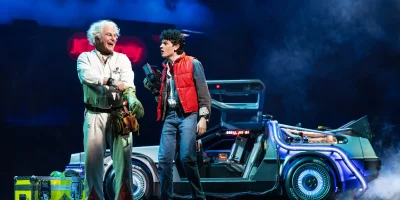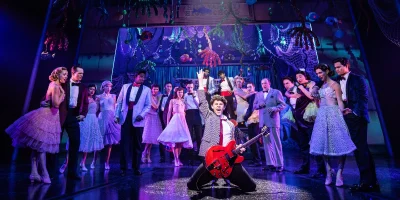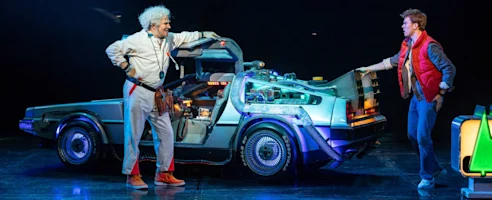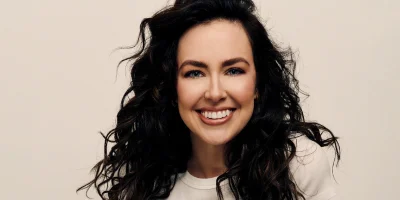
How the 'Back to the Future' musical pays homage to the '50s and '80s
The Broadway adaptation of the cult classic 1985 film is heavy with references to the different decades' pop culture, fashion, music, technology, and more.
Grab your flux capacitor and some plutonium — it’s time to travel back in time at Back to the Future. The Broadway musical adaptation of the 1985 film, whose book writer, Bob Gale, co-wrote the whole Back to the Future film franchise, is chock-full of references to 1980s pop culture. Those contrast the culture of the 1950s, where Marty McFly travels in time, with the help of the scientist Doc, and meets his teenaged parents.
In 1985, the kids hang out at the Twin Pines mall; in 1955, they go to Lou’s Café. In 1985, Marty’s older brother works at McDonald's; in 1955, they tout the newly invented Spam as the food of the future. But some '80s and '50s references do more than set the time and place: They tap into cultural nostalgia while moving the story forward or replicating an iconic movie moment.
So put on your puffy vest, bring your Polaroid, and drive over to the Winter Garden Theatre (at 88 miles per hour) to relive the past for yourself.

1980s vs. 1950s fashion
Costume and set designer Tim Hatley faithfully recreated not only the most iconic vintage looks from the Back to the Future movie, but also the overall trends and styles that defined each decade.
Orange puffer vest
The puffer vest is an American invention originating from Eddie Bauer’s 1930s puffer jacket. By the 1980s, neon versions of the jackets were trending in Milan. When Michael J. Fox wore an orange puffer vest as Marty McFly in the original Back to the Future film, he helped popularize the style across the U.S.
In the musical, the townspeople from 1955 don’t know what to make of Marty’s signature vest, asking him why he's wearing a life jacket. “Did you jump ship?” Lou jokes when Marty first enters his cafe. Pastels and jewel tones were in fashion back then, not 1980s neons. The contrast is clear in Hatley's costumes for the whole ensemble.
Denim on denim
In the 1980s, Marty also rocks the denim-on-denim look considered fashionable at the time. He wears jeans and a jean jacket at the beginning of the show when he auditions with his band, The Pinheads, to play at Hill Valley’s annual celebration day.
Once he gets acclimated to the 1950s, Marty swaps the denim for a preppy look: belted khakis and a varsity jacket. At the 1955 Enchantment Under the Sea school dance, Marty goes full retro in a formal checkered jacket, white button-down shirt, and red tie – a far cry from his 1980s rocker look.
Calvin Klein
Just as in the movie, Marty sports purple Calvin Klein underwear, which leads the 1955 version of his mother to call him Calvin. “That is your name, isn’t it?” she says to Marty upon first meeting him. “Calvin Klein. It’s written all over your underwear.”
Calvin Klein founded his clothing company in 1968, but it wasn’t until the 1980s that he rolled out his popular boxers and underwear – completely redefining the retail market for men’s undergarments.

1980s vs. 1950s transportation
It wouldn't be Back to the Future without the famous DeLorean. But there were plenty of other options back then for people who did need roads where they were going.
Skateboards
A quintessential 1980s kid, Marty skateboards around town in the film and stage versions of Back to the Future. Early skateboards were around in the 1950s, but they were associated with surfers in southern California. Hill Valley's teenagers would not have been accustomed to seeing people skateboarding down the street when Marty rolled into town.
The activity really took off with legendary skateboarders like Tony Hawk, who went pro in 1982 – three years before the Back to the Future film debuted. As Marty’s vest inspired a fashion trend, his skateboard inspired fans of the movie to learn to skate.
The DeLorean
While 1980s teens were skateboarding around town, the adults were driving. Doc’s DeLorean was an actual car model from the early 1980s — and one that might have spun out into oblivion if not for Back to the Future.
“Doc, are you telling me you built a time machine – out of a DeLorean?!” Marty asks the scientist. “Well, if you’re gonna build a time machine into a car, why not do it with some style?” Doc answers, going on to rhyme “glory in” and “story in” with “stainless steel DeLorean” in the exuberant song "It Works."
The Detroit-based DeLorean Motor Company, named for founder John DeLorean, produced a stainless steel sports car with gull-wing doors that opened up instead of out. Unfortunately, due to several quality issues, the DeLorean was only on the market from 1981-1983, with fewer than 9,000 cars ever made.
For the Back to the Future musical, Hatley used 3D scanning technology to capture the look of an actual DeLorean and built his own version. The onstage replica includes the car’s famous gull-wing doors, and the creative team makes use of lighting, video design, and machinery to create the illusion that the car is speeding across time and space.
Back in the 1950s, a more popular car would’ve been a Studebaker — name-dropped in a radio announcement in the show — or the Ford Thunderbird. (Think Grease.)
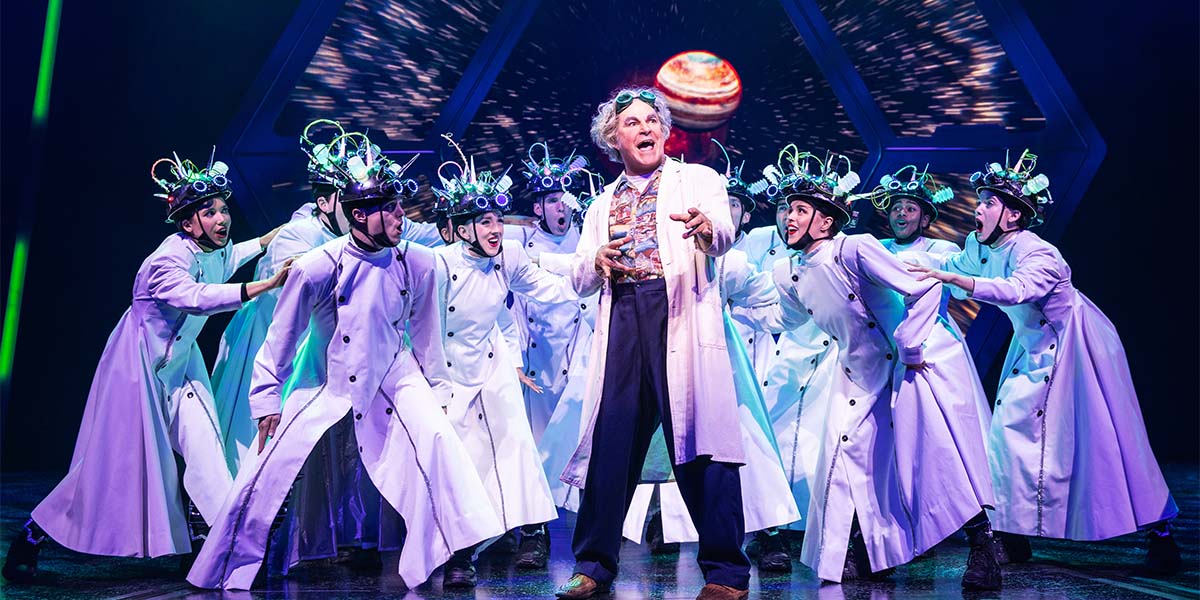
1980s vs. 1950s technology
The Act 1 song "Cake" sees the 1955 Hill Valley residents celebrate the era's groundbreaking inventions: filtered cigarettes, asbestos, DDT, and leaded gasoline. Discover more inventions that aged better — and which then-fictional technologies predicted future innovations.
Voice recording
At the top of the show, Doc uses a voice activation system that allows him to leave a pre-recorded message for Marty. By the mid-1980s, an early version of the answering machine was already in use. But it would’ve used magnetic tape or microcassettes to record messages, not Doc Brown’s fictional voice activation technology.
Camcorder
Doc Brown sets up a camera at the Twin Pines Mall in 1985 to capture his first successful attempt to go into the future. He tells Marty to film him as he demonstrates how the time-traveling DeLorean works. Instead, Marty ends up capturing a potentially fatal mistake Doc makes.
When Marty accidentally travels to 1955, he takes the camcorder with him and tries to share it with 1950s Doc Brown, who is wary of learning too much about his future.
Polaroid cameras
Marty’s girlfriend, Jennifer, has a Polaroid camera. After they kiss, they take a picture of themselves that develops instantaneously. Before the advent of digital cameras and phone cameras, Polaroid technology (which first came out in the late 1970s) was the only way to immediately see a photo without going through the arduous film development process.

1980s vs. 1950s music
Yes, your favorite '80s and '50s hits from the Back to the Future movie are in the musical. Most of the score by Alan Silvestri (who scored the film) and Glen Ballard is original, though, and blends the sounds of various eras.
Chiquita guitar
At the top of the show, Marty dreams of being a rock star on MTV – a timely reference since the channel first launched in 1981. He plays a yellow Erlewine Chiquita, an electric travel guitar that also came out in the early '80s.
Doo-wop vs. rock
In 1955, Marty is not exactly in sync with the music coming from the radio (“The Ballad of Davy Crockett”) or the high schoolers who prefer doo-wop to rock. Doo-wop originated in 1940s Chicago and became popular nationwide in the 1950s. An R&B-style precursor to rock and roll, the genre is known for intricate group harmonies and little instrumental accompaniment.
At the 1955 school dance, Marty sings anachronistic rock tunes including Chuck Berry’s 1958 hit "Johnny B. Goode" (which Fox, as Marty, also performed in the film). Although Marty gives it his all, the 1955 Hill Valley High students aren’t sure what to make of such futuristic music. "I guess you guys aren't ready for that yet," Marty says. "But your kids are gonna love it."
When Marty returns home to 1985, the town is more open to his taste, and Marty leads the company in Huey Lewis’s “The Power of Love,” which was written for the movie.

1950s vs. 1980s pop culture
Learn about more miscellaneous references to the culture of the '50s and '80s in Back to the Future on Broadway. Keep an ear out for them when you go!
Ronald Reagan
Before Reagan became the 40th U.S. president, he started his career as Hollywood star from the 1930-60s — an ad for his film Cattle Queen of Montana can be heard on the radio in the musical.
When 1955 Doc, not believing Marty is from the future, asks him who's president in 1985, Marty's answer of Reagan just makes Doc doubt him more. "The actor?" Doc scoffs. "Then who’s vice president — Daffy Duck?"
McDonald's
"Well, you're asking me to make a rather substantial investment in Scottish hamburgers. Look, I'm sorry, I just don't see how this is going to catch on, Mr. McDonald."
That's how we're first introduced to 1955 Doc, who 30 years later is probably regretting that missed opportunity. McDonald's was founded in 1940, but it only achieved global popularity decades later. Doc's parting words to Mr. McDonald — "Have it your way" — nod to the longtime slogan of competing chain Burger King, founded in 1954.
Frequently asked questions
What is Back to the Future about?
Great Scott, the classic time-traveling movie is now a Broadway musical. Join Marty McFly's plutonium-powered adventure from 1985 to 1955, where he almost prevents his parents from meeting and has to make things right. The stage version features new songs alongside the film's hits, like "The Power of Love." Find out more about tickets.
Where is Back to the Future playing?
Back to the Future is playing at Winter Garden Theatre. The theatre is located at 1634 Broadway (between 50th and 51st Street), New York, 10019.
How long is Back to the Future?
The running time of Back to the Future is 2hr 35min. Incl. 15min intermission.
What's the age requirement for Back to the Future?
The recommended age for Back to the Future is Ages 6+. Children under 4 are not permitted..
How do you book tickets for Back to the Future?
Book tickets for Back to the Future on New York Theatre Guide.
Is Back to the Future: The Musical based on the movie?
Back to the Future: The Musical is based on the movie. The stage show has the same plot and characters, but the musical adds more original songs alongside the film's most famous tunes.
Who wrote Back to the Future: The Musical?
Bob Gale, a co-writer of the original film's script, wrote the script for Back to the Future: The Musical. Alan Silvestri and Glen Ballard wrote the music and lyrics; Silvestri previously composed the film's score.
Are the songs from the Back to the Future movie in the musical?
Yes, "The Power of Love," "Johnny B. Goode," and "Earth Angel" all appear in Back to the Future on Broadway. The rest of the musical's score consists of new, original songs by Alan Silvestri and Glen Ballard.
Who plays Doc Brown in Back to the Future: The Musical?
Roger Bart plays Doc Brown in Back to the Future: The Musical, reprising the role from the world-premiere production in London. He's best known for You're a Good Man, Charlie Brown, for which he won the Tony Award for Best Featured Actor in a Musical.
Who plays Marty McFly in Back to the Future: The Musical?
Casey Likes plays Marty McFly in Back to the Future on Broadway. He's also known for playing William Miller in the Broadway adaptation of Almost Famous and Gene Simmons in the film Spinning Gold.
Is Back to the Future: The Musical appropriate for kids?
Back to the Future: The Musical is recommended for kids age 6 and up. The show contains some brief sexual themes, but the content is otherwise appropriate for children. Please note that children 4 and younger are not permitted in Broadway theatres.
Who directed Back to the Future: The Musical?
John Rando directs Back to the Future on Broadway. He is a Tony Award winner for staging Urinetown and a nominee for On the Town. He's also known for directing shows like The Wedding Singer and Mr. Saturday Night, also adapted from popular films.
Is Back to the Future on Broadway good?
New York Theatre Guide's four-star review reads, "The musical adaptation, now on Broadway with 1.21 gigawatts of spectacle... gives Back to the Future the larger-than-life presentation it deserves. The show is a great option for fans of the movie and anyone looking for an energetic show with impressive design and special effects.
Originally published on

